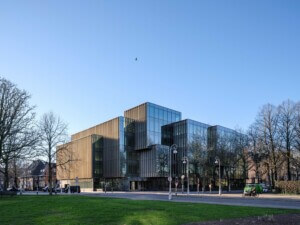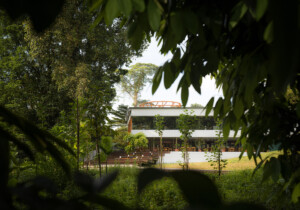As with much of OMA’s recent work, the firm’s latest building is exemplary for what it lacks. Instead of the complex structural flourishes of the CCTV Headquarters and many of the firm’s other mid-aughts projects, the Pierre Lassonde Pavilion at the Musee National des Beaux Arts du Québec (MNBAQ) is a lesson in more subtle design maneuvers: Its stacked massing, articulated in three varieties of glass, contains contemporary Québécois art and design galleries connected by a curvilinear glass balustrade and a predominantly white palette. Yet the most notable absence at the June 24 inauguration was that of OMA founder Rem Koolhaas. Instead, Shohei Shigematsu, who heads the firm’s New York office and served as partner-in-charge on the MNBAQ addition, spoke on behalf of the firm and explained that changes are indeed underway inside OMA as he led press and visitors through the new building.
Koolhaas’s absence at the inauguration by no means signals his retreat from design duties at the firm that, until recently, derived nearly all of its notoriety from the prestige associated with his own work and name. He continues to lead many of the firm’s most high-profile projects, last year’s Fondazione Prada in Milan and next year’s Taipei Performing Arts Center among them. Yet the pronounced emphasis at the recent inauguration on Shigematsu’s tenure as director of OMA New York bespeaks a new phase in OMA’s trajectory, one in which numerous of the firm’s seven partners work with greater autonomy from Koolhaas himself. “Me being recognized or other partners being recognized — not just Rem, actually reinforces the identity of the organization,” Shigematsu told The Architect’s Newspaper at the Québec inauguration. He is by no means an outlier in this development. Rotterdam-based partners Reinier de Graaf and Ippolito Pestellini Laparelli have also grown prominent within the OMA cosmology in recent years, the former as a polemicist and the latter for his preservation work and leadership of the firm’s ongoing, manifold collaboration with Prada. The present devolution of design authority is markedly different from the firm’s operations a decade prior, when numerous of the leading architects at OMA, like Bjarke Ingels, Ole Scheeren, and Joshua Prince-Ramus, began leaving to open their own offices. “I’m basically, probably doing the same thing inside [the firm],” Shigematsu noted, “A lot of senior people have started to stay.”
On the Grande Allée in Québec City, the Pierre Lassonde Pavilion acts as an intermediary between traffic along one of the city’s main arteries and the National Battlefields Park where the museum’s three other buildings are situated. The new building also expands connections between the capital of Francophone Canada and the international art milieu, as it shares formal tropes with recent cultural institutions designed elsewhere by OMA (the MNBAQ’s gold elevator core shares a chromatic palette with Prada and Laparelli’s recently-completed Fondaco dei Tedeschi in Venice, Italy). Shigematsu is quick to note that the shared color schemes across partners are part and parcel of an expanding practice: “Not just metallic, but the attention to detail and refinement that we can bring,” he mused. “We have the luxury to now build so much with a sense of maturity as an architecture firm.”










